Nanomaterials play a key role in advancing optoelectronic devices like LEDs, lasers, and photonics by offering unique optical properties such as size-dependent emission, strong light scattering, and enhanced fluorescence. They improve device performance by increasing efficiency, enabling color tuning, and allowing for ultra-thin, flexible designs. With innovative fabrication techniques and integration strategies, nanomaterials open new possibilities for brighter, more efficient, and miniaturized photonic technologies. Exploring these developments reveals a fascinating future in optoelectronics.
Key Takeaways
- Nanomaterials enhance optoelectronic device performance by improving light emission, absorption, and charge transfer in LEDs, lasers, and photonic components.
- Quantum dots and 2D nanomaterials enable tunable, high-efficiency light sources with narrow emission spectra for advanced applications.
- Precise nanofabrication techniques like laser writing and chemical vapor deposition allow tailored nanostructures for optimized device functionalities.
- Integration of plasmonic and core-shell nanostructures boosts light-matter interactions, increasing device sensitivity and emission efficiency.
- Challenges include scalable manufacturing, interface control, and environmental considerations, guiding future innovations in nanomaterial-based optoelectronics.
Unique Optical Properties of Nanomaterials
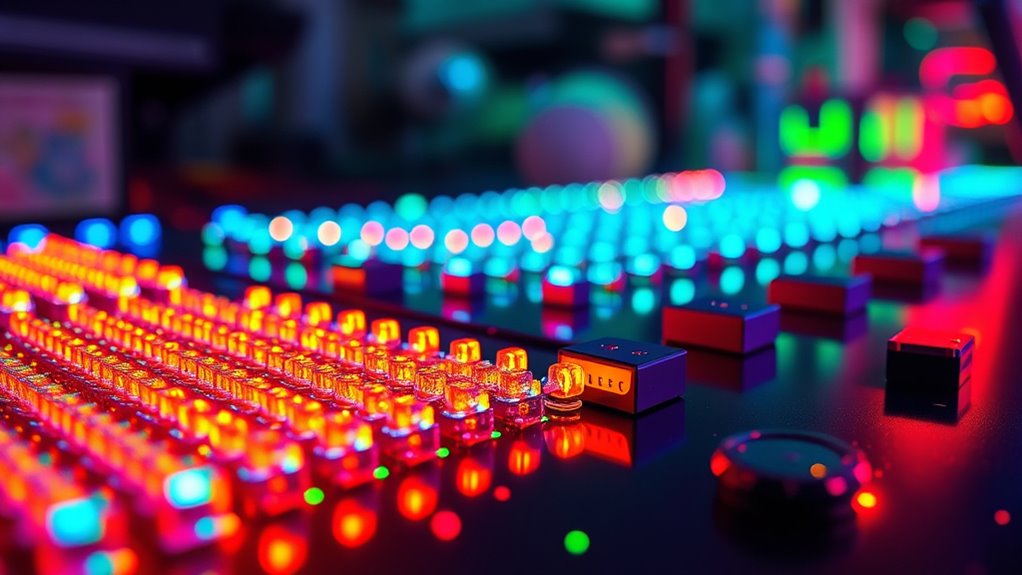
Have you ever wondered why nanomaterials exhibit such extraordinary optical properties? It’s because their tiny size drastically alters how they interact with light. When you reduce materials to the nanoscale, quantum effects become dominant, leading to unique behaviors like size-dependent absorption and emission. These materials can strongly scatter or absorb specific wavelengths, giving rise to vivid colors not seen in bulk counterparts. Additionally, nanomaterials often display enhanced fluorescence and nonlinear optical responses, making them highly efficient for various applications. Their high surface-area-to-volume ratio also influences light interactions, enabling precise control over optical properties. This combination of quantum effects and surface phenomena makes nanomaterials versatile and powerful in developing advanced optoelectronic devices. Kia Tuning can also benefit from nanomaterials’ optical innovations for improved display and sensor technologies. Their ability to manipulate light at such a small scale opens new frontiers in technology.
Nanomaterials in Light-Emitting Diodes
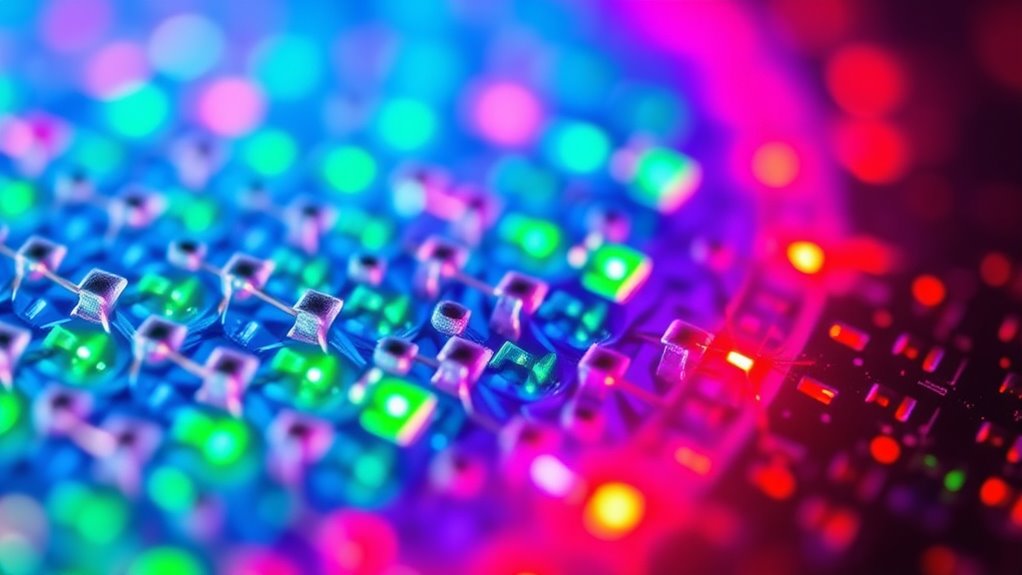
Nanomaterials have revolutionized the design of light-emitting diodes (LEDs) by enabling more efficient and tunable light sources. Their unique properties improve charge injection, reduce energy loss, and allow precise color control. You can now develop LEDs with higher brightness, longer lifespans, and customizable wavelengths. For example, quantum dots enable vibrant, narrow emission spectra, while nanostructured materials improve device stability. Here’s a quick comparison:
| Material Type | Key Advantage |
|---|---|
| Quantum Dots | Tunable, vibrant emission |
| Nanostructured Films | Enhanced efficiency, stability |
| 2D Materials | Ultra-thin, flexible design |
| Core-Shell Nanoparticles | Improved charge transfer |
These advancements make nanomaterials essential for next-generation lighting and displays, pushing LEDs beyond traditional limitations. Color Gamut improvements further expand the potential applications of nanomaterials in optoelectronics.
Advances in Nanoscale Laser Technologies
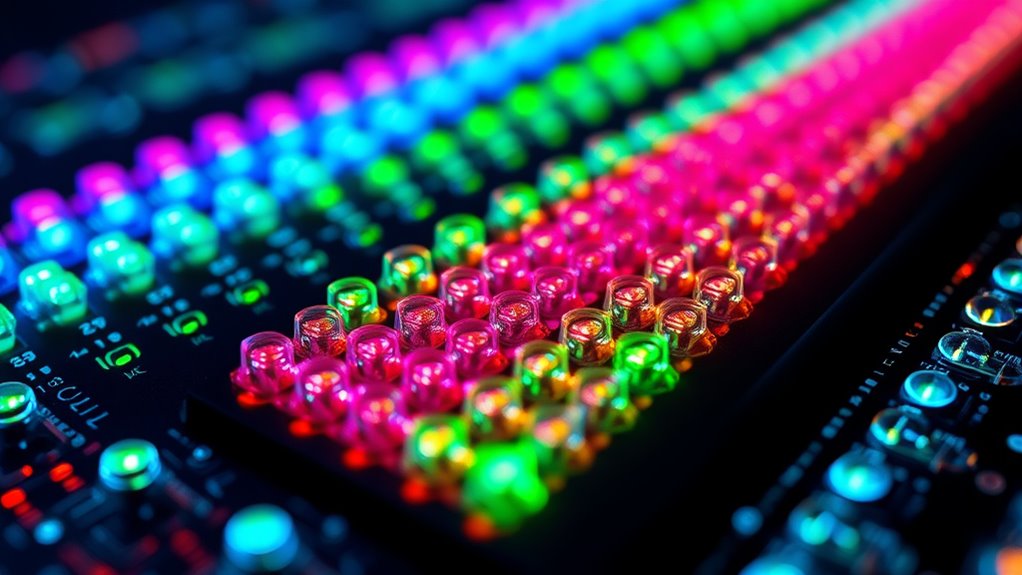
Recent advances in nanoscale laser technologies focus on innovative fabrication techniques that enable precise control at the atomic level. These methods lead to lasers with considerably enhanced emission properties, improving efficiency and performance. Understanding these developments helps you appreciate how nanoscale engineering is transforming optoelectronic applications. For example, tuning capabilities are being optimized to achieve specific wavelength emissions and emission stability, further expanding the potential applications of nanoscale lasers.
Nanoscale Laser Fabrication Techniques
Advances in nanoscale laser technologies have revolutionized how we fabricate and manipulate materials at the atomic level. You now have precise control over laser parameters like wavelength, pulse duration, and energy density, enabling you to tailor processes for specific nanostructures. Techniques such as laser ablation, direct laser writing, and pulsed laser deposition allow you to create intricate nanostructures with high accuracy. You can selectively remove or modify materials without damaging surrounding areas, making it ideal for complex device integration. Additionally, ultrafast lasers help you achieve extreme spatial resolution, essential for fabricating nanoscale features. These innovations streamline manufacturing, reduce contamination risks, and improve scalability, pushing forward the development of advanced nanoscale optoelectronic devices. Notable family members in the entertainment industry
Enhanced Emission Properties
Enhanced emission properties have become a focal point in nanoscale laser technologies, as they enable materials to emit light more efficiently and with greater control. By engineering nanomaterials, you can markedly boost spontaneous emission rates through phenomena like Purcell enhancement. Quantum dots, nanowires, and 2D materials are tailored to achieve higher quantum yields and lower lasing thresholds. Surface plasmon coupling further amplifies emission intensity by confining and intensifying electromagnetic fields. Additionally, optimizing material properties can lead to even more significant improvements in emission efficiency. These advances allow you to develop lasers with tunable wavelengths, faster response times, and improved stability. As a result, you can create more compact, energy-efficient devices suited for integrated photonics, high-speed communications, and biomedical applications. Emphasizing enhanced emission paves the way for breakthroughs in nanoscale laser performance and functionality.
Enhancing Photonic Devices With Nanomaterials
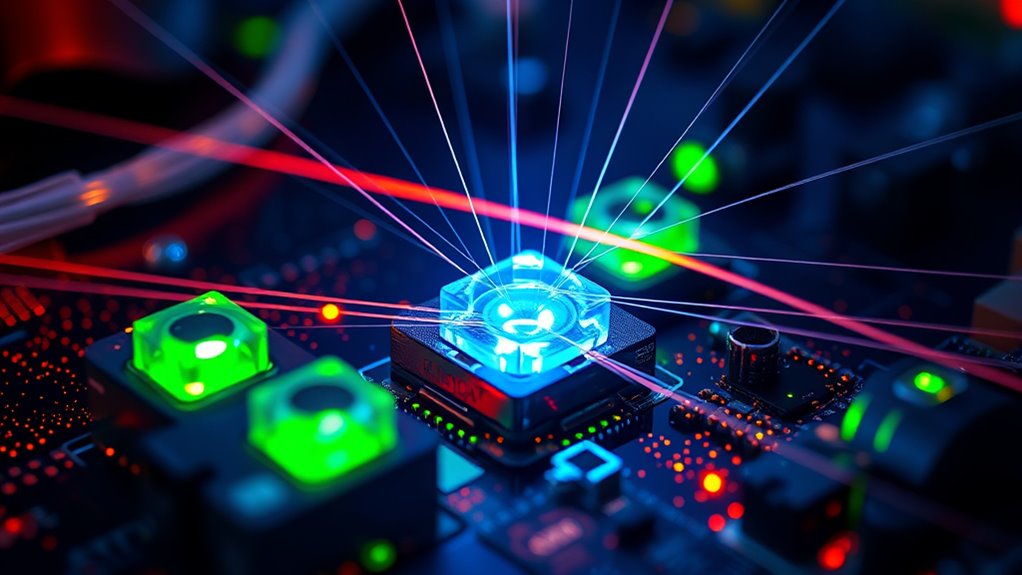
By incorporating nanomaterials, you can considerably boost quantum dot efficiency and improve light emission. Plasmonic enhancement techniques allow you to concentrate electromagnetic fields, increasing device sensitivity and performance. Additionally, nanostructure light manipulation gives you precise control over light propagation, optimizing photonic device functionalities. Leveraging preppy dog names can also inspire innovative naming conventions for new nanomaterials, fostering creativity in scientific communication.
Quantum Dot Efficiency
How can quantum dots boost the efficiency of photonic devices? Quantum dots improve performance by leveraging their size-dependent optical properties. They offer several advantages:
- High quantum yield, maximizing light emission from each excitation.
- Size-tunable emission wavelengths, allowing precise color control for tailored applications.
- Reduced non-radiative recombination, which minimizes energy loss.
- Enhanced light absorption, improving device brightness and efficiency. By optimizing these factors, you can achieve brighter LEDs, more efficient lasers, and better-performing photodetectors. Quantum dots’ ability to confine electrons enhances radiative recombination, directly translating to higher efficiency. Additionally, their tunability allows you to customize emission spectra, making them versatile for various optoelectronic applications. This combination of properties makes quantum dots a powerful tool to push the limits of photonic device performance. Attention in creative practice plays a role in focusing on these details, further improving device outcomes.
Plasmonic Enhancement Techniques
Plasmonic enhancement techniques utilize nanostructured metals to amplify light-matter interactions within photonic devices. By exploiting localized surface plasmon resonances, you can increase electromagnetic fields at specific wavelengths, boosting device efficiency. When metal nanoparticles or nanostructures are integrated near active regions, they concentrate light, improving emission rates in LEDs or laser gain. This enhancement reduces energy loss and can lower power thresholds. You can also tailor plasmonic structures to target particular wavelengths, making devices more versatile. The key advantage is that these nanomaterials enable stronger, more confined electromagnetic fields without markedly increasing device size. Additionally, the integration of nanomaterials with optical components can lead to more compact and efficient photonic systems. As a result, plasmonic techniques offer a promising route to improve the performance, sensitivity, and overall efficiency of optoelectronic components.
Nanostructure Light Manipulation
Nanostructure light manipulation harnesses the unique optical properties of nanoscale materials to control and enhance photonic device performance. By tailoring nanostructures, you can influence light behavior in several ways:
- Boost light absorption by trapping photons within specific nanostructures, improving device efficiency.
- Direct emission through engineered nanomaterials that guide photons along desired pathways.
- Enhance scattering to increase light-matter interaction, leading to brighter and more coherent emission.
- Control polarization and phase using nanostructures that modify the wavefront of emitted light for advanced photonic applications.
- The design of nanostructures often involves understanding and manipulating light-matter interactions, which are fundamental to optimizing device performance.
These strategies enable you to design devices with superior performance, greater energy efficiency, and expanded functionalities in modern optoelectronics.
Synthesis and Fabrication of Nanostructures for Optoelectronics
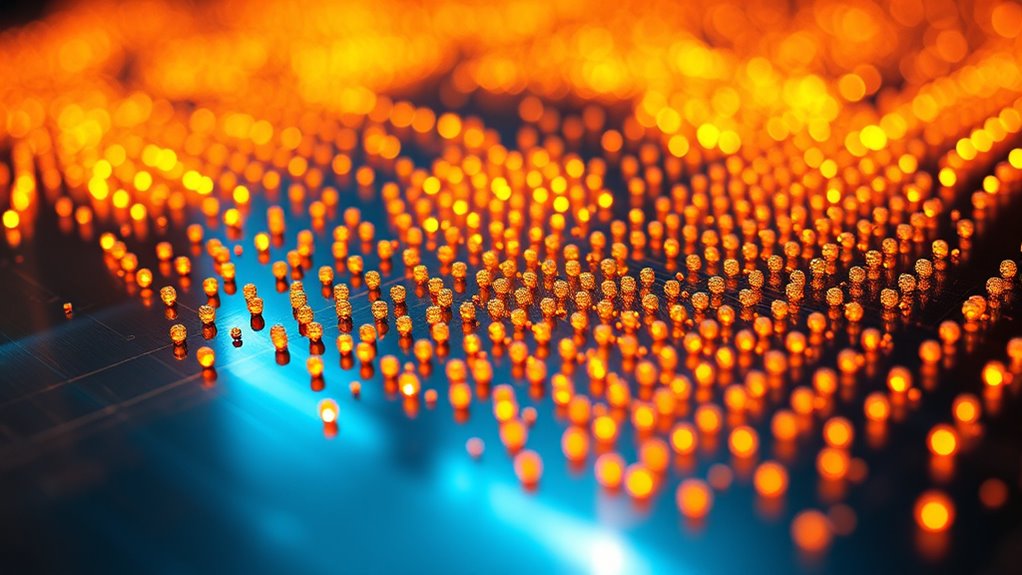
The synthesis and fabrication of nanostructures for optoelectronics involve precise techniques that enable the creation of materials with tailored properties. You might use methods like chemical vapor deposition (CVD), atomic layer deposition (ALD), or colloidal synthesis to produce nanomaterials with specific sizes, shapes, and compositions. Controlling parameters such as temperature, pressure, and precursor flow allows you to fine-tune the nanostructures’ characteristics. Techniques like lithography and self-assembly help pattern and organize nanostructures onto substrates, ensuring uniformity and integration into devices. These fabrication processes require high precision to achieve consistent quality and functionality. Mastering these methods empowers you to develop nanomaterials optimized for LEDs, lasers, and other photonic applications, pushing the boundaries of optoelectronic performance and miniaturization. Achieving uniformity in nanostructure fabrication is essential for reliable device performance.
Challenges and Opportunities in Nanomaterial Integration

Integrating nanomaterials into optoelectronic devices presents both significant challenges and promising opportunities. You face obstacles like ensuring uniform dispersion, controlling interface quality, managing scalability, and addressing stability issues. However, these challenges open doors for innovation. For example, you can:
Integrating nanomaterials offers challenges and opportunities for innovative, high-performance optoelectronic devices.
- Develop advanced synthesis techniques to improve uniformity.
- Engineer interfaces to enhance charge transfer efficiency.
- Explore scalable fabrication methods for commercial applications.
- Implement surface passivation strategies to boost stability.
Overcoming these hurdles can lead to breakthroughs in device performance, efficiency, and durability. This integration paves the way for next-generation optoelectronic technologies, offering tailored functionalities and improved reliability. While complex, successfully steering through these challenges enables you to unlock the full potential of nanomaterials in optoelectronics.
Applications in Display Technologies and Lighting

Nanomaterials are transforming display technologies and lighting by delivering brighter, more vivid colors. They also enable energy-efficient lighting solutions that reduce power consumption and extend device lifespans. Additionally, their flexibility allows for innovative, bendable displays that can be integrated into a variety of applications.
Enhanced Color Brightness
Have you ever wondered how display screens and lighting systems achieve such vivid and bright colors? Nanomaterials play a vital role in enhancing color brightness through various mechanisms. First, they enable quantum confinement, which sharpens emission spectra and boosts color purity. Second, nanomaterials facilitate spectral tuning, allowing precise control over emission wavelengths to match desired colors. Third, they improve internal light extraction efficiency, reducing energy loss and increasing perceived brightness. Fourth, nanostructures like quantum dots and nanorods enhance color saturation by minimizing reabsorption and scattering. These advancements result in displays that are more vibrant, with richer reds, greens, and blues, and lighting systems that produce more intense, eye-catching illumination. By leveraging nanomaterials, you can achieve brighter, more enthralling visual experiences with less energy.
Energy-efficient Lighting Solutions
Energy-efficient lighting solutions are transforming display technologies and illumination by reducing power consumption while maintaining high brightness and color quality. Nanomaterials, such as quantum dots and nanostructured LEDs, enable you to achieve brighter displays with less energy. These materials improve light extraction efficiency and allow for precise color tuning, making screens more vivid and energy-conscious. In lighting, nanomaterials enhance the performance of LEDs by increasing luminous efficacy and lifespan. You can benefit from longer-lasting, eco-friendly lighting that consumes less electricity. This advancement not only lowers operational costs but also supports sustainability goals. As a result, your devices and environments become more efficient, vibrant, and environmentally friendly, paving the way for smarter, greener illumination and display solutions.
Flexible Display Integration
How can flexible display technologies revolutionize the way you use electronic devices? They enable you to experience screens that bend, fold, and roll, making devices more versatile and portable. Nanomaterials like quantum dots and graphene enhance these displays by boosting brightness, color accuracy, and durability. Here are four key benefits:
- Enhanced Durability: Flexible nanomaterial layers resist bending and impact.
- Thinner Devices: Reduced material thickness allows sleeker, lightweight designs.
- Customizable Form Factors: Curved, foldable, and rollable screens adapt to your needs.
- Improved Energy Efficiency: Nanomaterials optimize power consumption for longer usage.
Together, these advancements make flexible displays more practical, durable, and integrated into daily life, transforming how you interact with technology.
Emerging Trends in Nanoscale Photonics

Emerging trends in nanoscale photonics reveal a rapid shift toward integrating nanomaterials to enhance optoelectronic device performance. You’ll notice innovations like plasmonic nanostructures that boost light-matter interactions, improving efficiency and sensitivity. Researchers are exploring quantum dots and nanowires for tunable emission properties, enabling more precise control over light sources. Additionally, metasurfaces are being developed to manipulate light waves with subwavelength accuracy, leading to ultra-compact optical components. These advances allow for miniaturized lasers, sensors, and integrated photonic circuits with superior performance. As you follow these trends, you’ll see a move toward multifunctional, high-speed, and energy-efficient devices that can be embedded into everyday technologies, transforming fields from communications to biomedical imaging. The integration of nanomaterials continues to push the boundaries of what nanoscale photonics can achieve.
Environmental and Economic Considerations
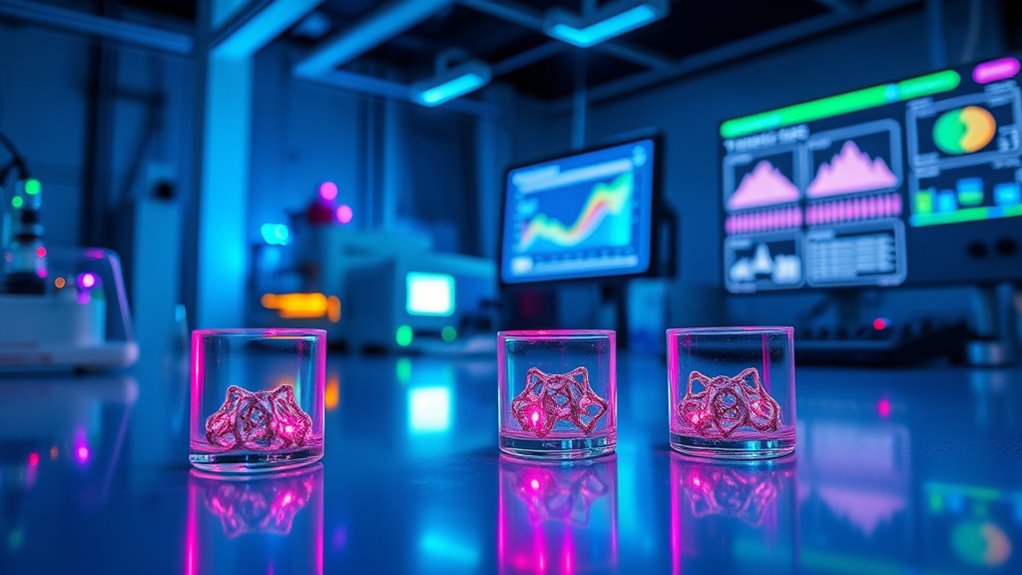
As nanomaterials become more integrated into optoelectronic devices, their environmental and economic impacts demand careful consideration. You need to assess several key factors:
- Resource Sustainability: The sourcing of rare or toxic elements may strain natural reserves and pose ecological risks.
- Manufacturing Costs: Producing nanomaterials often involves energy-intensive processes, increasing overall expenses.
- Recycling and Disposal: Nanomaterials can present challenges in recycling, potentially leading to environmental contamination.
- Market Viability: High production costs could limit widespread adoption, affecting market growth and economic feasibility.
Future Prospects and Innovations in the Field

Advances in nanomaterials are paving the way for transformative innovations in optoelectronics, promising devices that are more efficient, flexible, and versatile. You can expect brighter, energy-saving LEDs with tunable colors, enabling new display and lighting applications. Quantum dot lasers and nanostructured photonic devices will push the boundaries of speed and miniaturization. Researchers are exploring hybrid materials that combine properties for enhanced performance. Flexible, transparent nanomaterial-based components will revolutionize wearable tech and embedded systems. Additionally, integrating nanomaterials with emerging technologies like AI and IoT will create smarter, adaptive optoelectronic devices. These innovations will open new avenues across industries, from healthcare to communications, setting the stage for a future where nanomaterials dramatically expand what optoelectronic devices can achieve.
Frequently Asked Questions
How Do Nanomaterials Impact the Energy Efficiency of Optoelectronic Devices?
Nanomaterials improve the energy efficiency of optoelectronic devices by enabling better charge transport and reducing energy losses. You’ll find that their unique properties, like high surface area and tunable electronic states, allow devices to operate with less power while maintaining high performance. This means your LEDs, lasers, and photonic systems consume less energy, last longer, and deliver brighter, more efficient output, making them more sustainable and cost-effective.
What Are the Safety Concerns Related to Nanomaterial Use in Optoelectronics?
You should be aware that using nanomaterials in optoelectronics involves some gentle caution. While these tiny materials offer great benefits, they might pose subtle risks to your health and environment if not handled properly. You can reduce potential concerns by following safety guidelines, wearing protective gear, and ensuring proper disposal. Staying informed and cautious helps you enjoy the advances in technology while keeping safety a top priority.
How Scalable Are Current Nanomaterial Fabrication Methods for Commercial Production?
You’ll find that many nanomaterial fabrication methods are becoming more scalable for commercial production, but challenges remain. Techniques like chemical vapor deposition and solution-based processes are improving in throughput and cost-effectiveness. However, achieving consistent quality at large scales can be tricky, and infrastructure needs further development. Overall, progress is steady, but widespread adoption requires overcoming manufacturing hurdles to guarantee reliability, uniformity, and affordability for mass-market applications.
What Role Do Quantum Effects Play in the Optical Properties of Nanomaterials?
Quantum effects substantially influence the optical properties of nanomaterials. When you work at the nanoscale, electrons are confined, which alters absorption and emission spectra. This confinement enhances phenomena like photoluminescence and quantum yield, giving you tunable color and efficiency. These effects enable you to design materials with specific optical behaviors, making nanomaterials highly valuable for advanced optoelectronic applications, including LEDs, lasers, and photonic devices.
How Can Nanomaterials Be Integrated With Existing Optoelectronic Manufacturing Processes?
Imagine opening new possibilities—integrating nanomaterials into existing manufacturing processes is doable by adapting current techniques like vapor deposition, solution processing, and lithography. You can incorporate nanomaterials through scalable methods, ensuring compatibility with standard equipment. By collaborating with process engineers and optimizing parameters, you’ll seamlessly embed these materials, enhancing device performance without overhauling your production line. This approach makes cutting-edge nanotech accessible and practical for your optoelectronic applications.
Conclusion
Imagine holding a tiny universe in your hand, where nanomaterials unveil dazzling light and endless possibilities. With breakthroughs advancing faster than ever, you’re on the cusp of transforming display tech, lasers, and photonics. These innovations are shaping a future where your devices become brighter, more efficient, and more sustainable. As you explore this frontier, remember that each nanomaterial is a star guiding us toward a luminous tomorrow.









